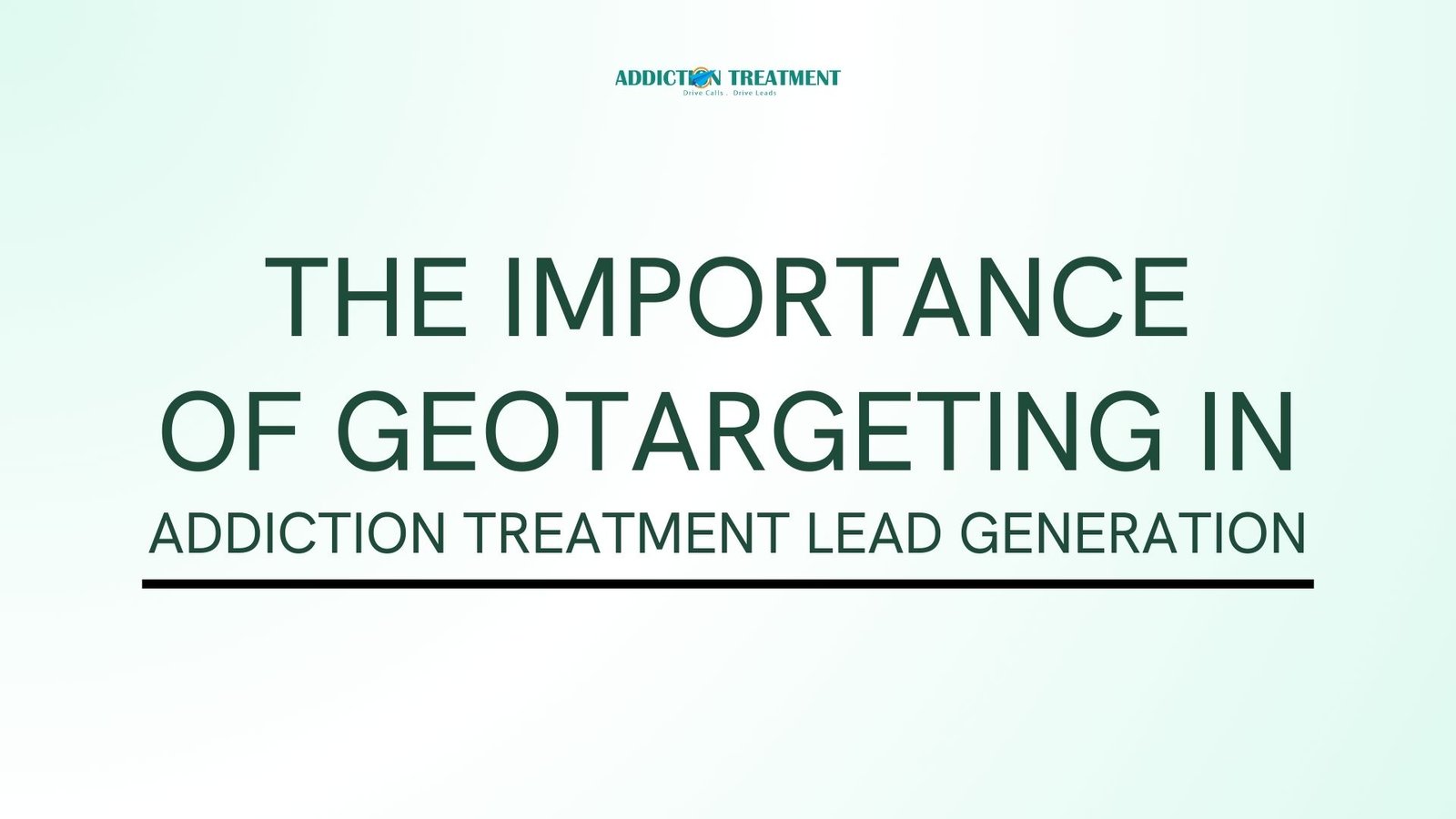In the competitive landscape of addiction treatment marketing, reaching the right audience at the right time is critical. Geotargeting, or location-based marketing, has emerged as a powerful tool to enhance lead generation for treatment centers. By tailoring campaigns to specific geographic areas, addiction treatment providers can connect with high-intent audiences, improve resource allocation, and ultimately increase conversions. This article explores the importance of geotargeting in addiction treatment lead generation, along with actionable strategies to implement it effectively.
What Is Geotargeting?
Geotargeting is a digital marketing strategy that uses a person’s geographic location to deliver relevant ads or content. This approach ensures that individuals in specific regions are targeted with campaigns tailored to their needs. For addiction treatment centers, geotargeting allows precise audience segmentation, improving the effectiveness of marketing efforts.
Why Geotargeting Matters in Addiction Treatment Marketing
Geotargeting is particularly important for addiction treatment centers because location plays a significant role in a person’s decision-making process when seeking help. Here’s why:
- Proximity to Services: People often look for treatment centers close to their homes or within a certain radius for convenience and accessibility.
- Localized Needs: Different regions may have unique challenges or trends in substance use, requiring tailored messaging.
- Resource Efficiency: By focusing on specific areas, centers can allocate their marketing budget more effectively.
Key Benefits of Geotargeting for Addiction Treatment Lead Generation
1. Improved Lead Quality
Geotargeting ensures that your ads reach people who are more likely to convert. For example, a treatment center in Florida targeting individuals searching for “addiction treatment near me” within a 50-mile radius will attract high-intent leads.
2. Increased Relevance
Localized campaigns allow you to tailor your messaging to resonate with the specific needs and preferences of the audience in a particular area. For instance, a region facing an opioid crisis might benefit from ads focusing on opioid addiction treatment.
3. Cost Efficiency
Instead of casting a wide net, geotargeting helps treatment centers focus their budget on areas with higher conversion potential. This reduces wasted ad spend on irrelevant audiences.
4. Enhanced Trust and Credibility
Localized ads and content create a sense of familiarity and trust. People are more likely to engage with a center that understands the unique challenges of their community.
Strategies for Effective Geotargeting in Addiction Treatment
1. Leverage Local Keywords
Incorporate location-specific keywords into your campaigns to improve visibility and relevance. Examples include:
- “Rehab centers in [City/State]”
- “Inpatient addiction treatment near [Location]”
- “Detox programs in [Region]”
Using tools like Google Keyword Planner can help identify high-performing local keywords.
2. Utilize Google Ads Location Targeting
Google Ads allows businesses to target audiences based on their geographic location. Key features include:
- Radius Targeting: Define a radius around your center to focus on nearby audiences.
- Location Groups: Target specific types of locations, such as cities, counties, or zip codes.
- Exclusion Zones: Exclude areas outside your service range to avoid irrelevant clicks.
3. Create Location-Specific Landing Pages
Develop dedicated landing pages for each target location to enhance the user experience and improve SEO. These pages should include:
- Localized content addressing community-specific needs.
- Clear information about your services and proximity to the area.
- Call-to-action buttons like “Call Now” or “Schedule a Visit.”
4. Run Geo-Fenced Ads
Geo-fencing allows you to deliver ads to users within a defined geographic boundary, such as a city or neighborhood. This is especially useful for:
- Targeting attendees at local events related to health and wellness.
- Reaching people visiting nearby hospitals, clinics, or counseling centers.
5. Incorporate Social Media Geotargeting
Social media platforms like Facebook, Instagram, and LinkedIn offer advanced geotargeting options. You can use these features to:
- Run location-based ads tailored to specific demographics.
- Boost posts promoting localized events or services.
- Target users who have checked into similar facilities or addiction-related events.
6. Analyze Regional Trends
Understanding regional trends in substance use and addiction can help refine your campaigns. For example:
- Use government reports or studies to identify areas with high rates of substance abuse.
- Adapt your messaging to address the specific substances or challenges prevalent in each region.
7. Monitor and Optimize Campaign Performance
Regularly track the performance of your geotargeted campaigns to ensure they are delivering results. Focus on metrics such as:
- Click-Through Rate (CTR): Indicates how engaging your ads are to the target audience.
- Cost Per Click (CPC): Helps evaluate the efficiency of your budget allocation.
- Conversion Rate: Measures the percentage of leads who take desired actions, such as calling or filling out a form.
Challenges of Geotargeting and How to Overcome Them
1. Limited Audience Size
Focusing on specific areas may limit the reach of your campaigns. To address this:
- Expand the radius or add nearby locations if lead volume is too low.
- Use broad targeting initially and refine based on performance data.
2. Regulatory Restrictions
Certain advertising platforms have restrictions on addiction treatment ads. Ensure compliance by:
- Obtaining LegitScript certification for platforms like Google.
- Adhering to local laws and advertising guidelines.
3. High Competition
In densely populated areas, competition for local keywords and ad placements can drive up costs. Combat this by:
- Focusing on underserved regions or smaller communities.
- Optimizing your campaigns for mobile users who are more likely to perform local searches.
Real-World Examples of Geotargeting in Addiction Treatment
- Small-Town Focus: A rehab center in a rural area creates Facebook ads targeting nearby zip codes, emphasizing its close-knit community approach.
- Event-Based Campaigns: A center in a metropolitan area uses geo-fencing to target attendees of a mental health awareness event with ads promoting its services.
- Localized Content: A Florida-based treatment center develops landing pages for Miami, Tampa, and Orlando, highlighting location-specific programs and success stories.
Future Trends in Geotargeting for Addiction Treatment
As technology evolves, geotargeting is becoming even more sophisticated. Emerging trends include:
- AI-Powered Targeting: Artificial intelligence will provide deeper insights into location-based behaviors and preferences.
- Voice Search Optimization: As voice searches like “rehab near me” become more common, optimizing for conversational queries will be critical.
- Hyperlocal Targeting: Advances in GPS technology will enable even more precise targeting, down to individual neighborhoods or blocks.
Conclusion
Geotargeting is a game-changer for addiction treatment lead generation, enabling centers to connect with the right audience in the right place. By leveraging location-based strategies such as localized keywords, geo-fenced ads, and regional insights, treatment providers can improve lead quality, enhance engagement, and maximize their marketing ROI. As technology and consumer behavior continue to evolve, embracing geotargeting will remain essential for success in the addiction treatment industry.


Leave a Reply